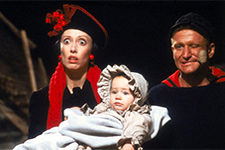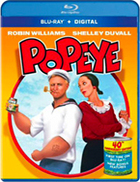Popeye
|  In the highest echelon of glorious misfires, Robert Altman’s Popeye ranks in the top tier. A would-be blockbuster co-financed by two major studios (Paramount and Disney), Popeye is a bizarre hybrid of high-concept Hollywood profiteering and the intrepid artistry of a once-vaunted auteur at the edge of a deep career decline that would last a decade. Add into all that the fact that it is a musical, was the first starring role for Robin Williams, and had a production fraught with problems and delays, and you have a unique bust that defines the uneasy collision of the ’70s and ’80s in American cinema. The translation of one-dimensional cartoons into two-dimensional flesh and blood is nothing new for Hollywood—never has been. Batman, Superman, Flash Gordon, Dick Tracy, Li’l Abner, The Phantom, and numerous other characters who had begun life as static drawings on the page had been turned into live-action movies prior to Popeye, whose title character was first introduced in 1929 as part of E.C. Segar’s daily King Features comic strip Thimble Theatre. Yet, the idea of turning Popeye—that strange, unevenly bloated cartoon sailor with the squinty eye, the biceps in his forearms, and the raspy, muttering chuckle—into a live-action creation seems particularly strange. Of course, that’s never stopped Hollywood, especially in an era like the early 1980s, when the idealistically auteur-driven ’70s was giving way to a decade of producer-driven concept movies designed to enthrall audiences with spectacle and reap big profits. Enter Robert Altman, one of the most notoriously difficult and single-minded directors of the 1970s. The man behind such subversive, revisionist genre works as McCabe & Mrs. Miller (1971), The Long Goodbye (1973), and Nashville (1975) was falling on hard times by the end of the decade, and Popeye was his last bid to stay in the game (you can almost feel the desperation in each frame, although optimists and auteurists have plenty of room to read it as innovation and experimentation). Despite performing well theatrically (it ranked 11th at the 1980 U.S. box office), it was not enough to justify the film’s large budget, and it was generally decried by critics who saw it as a sell-out for Altman and not a particularly good one at that. As a result, Altman spent most of the 1980s directing television and low-budget movies based on stageplays until his return to form in 1992 with The Player. Yet, decades after its release, many critics have given Popeye a second look and reassessed its artistic merits. Auteurist-minded critics have been its most vocal defenders, placing it squarely within Altman’s larger body of work and arguing for thematic and stylistic parallels with some of his best films, particularly McCabe & Mrs. Miller. Yet, such arguments feel strained at best, dishonest at worst, because, truth be told, Popeye is a mess. That doesn’t mean it’s a bad movie, but it lacks the coherent artistic vision and thematic strength that made many of Altman’s other films so great. In his first starring role, Robin Williams (then known for his role on the TV sitcom Mork and Mindy) deftly embodies Popeye, complete with corncob pipe, perpetually squinted eye, and prosthetically enhanced forearms. He arrives on a small dingy in the seaside town of Sweethaven, a marvel of production design built on a craggy lagoon on the island of Malta. Sweethaven itself is a ramshackle town in decline, all its buildings decaying and tilting, many on the verge of toppling over. The town itself stands in stark contrast to the environment around it, particularly the crystal blue waters of the ocean, which seem almost surreal (the juxtaposition of nearly monochromatic browns and grays with bursts of sensuous color is the film’s visual signature). Ostensibly set in the U.S., Sweethaven is everywhere and nowhere, a fantasy world completely cut off from any other civilization (although, ironically, the set has been maintained in the decades since production wrapped and is now a popular tourist destination in Malta). Popeye takes up residence in a boarding house run by the Oyl family. There, of course, he meets Olive Oyl (Shelley Duvall, who looks so much like the cartoon character it’s scary). Olive is on-again-off-again engaged to the brutish Bluto (Paul L. Smith), whose communication consists largely of snorting like a bull and grimacing. He has two emotional modes: irritated and enraged. Bluto and his muscles are in the service of the mysterious and never-seen Commodore, a tyrant who runs Sweethaven and collects taxes on virtually everything (as soon as Popeye arrives, he is accosted by the taxman, amusingly played by Donald Moffat). The residents of Sweethaven seem to accept their lousy lot in life without much complaint, and out-of-work schlubs like Wimpy (Paul Dooley) hang around the edges of the widescreen frame, reminding us of the socioeconomic misery. The story, penned by cartoonist-turned-playwright and screenwriter Jules Feiffer (Carnal Knowledge), meanders along in starts and fits without ever seeming to have much of a purpose. Feiffer includes all the major characters we associate with the Popeye cartoons, including the baby Swee’pea (Wesley Ivan Hurt), who Popeye finds abandoned and who serves as the catalyst to bring him and Olive together as a couple. While rarely if ever laugh-out-loud funny, Popeye contains numerous clever moments and sight gags, many of which are played out in the overcrowded background and only come to one’s attention with a second or third viewing (it is as if Altman is trying to channel Jacques Tati). However, if the story and the jokes are somewhat spare, the mise-en-scene is an overwhelming muddle, constantly threatening to swallow up the major characters and turn them into so much background detail. Altman packs the frame with characters and scenery, which is a typical visual strategy for him, but here becomes distracting because it’s so overdone and there’s so little narrative impetus for it. There are characters everywhere (many of whom are played by European circus performers), but virtually none of them matter, which is the exact opposite of most of Altman’s character-driven ensemble films such as M*A*S*H (1970), Nashville, and Short Cuts (1993). The musical numbers are similarly busy and look intentionally sloppy, featuring not so much choreographed dancing as just constant movement. All of the songs were penned by prolific singer/songwriter Harry Nilsson, but many of them feel bland or tossed off (Bluto’s big number, “I’m Mean,” consists primarily of him repeating “I’m mean, I’m mean, I’m mean, if you know what I mean” while smashing things and pummeling people). There are a few songs that work well, primarily those that involve only one or two characters, which allows Altman to focus on the meaning. This is particularly true of the duet in which Popeye and Olive gently sing discordant verses to Swee’pea, Popeye’s about his dream of the boy sailing away with him and Olive’s about her dream of the boy staying at home with her. The best number by far, though, is “He Needs Me,” Olive’s loose-limbed ode to being needed in which she wraps herself around light posts as she sings up to Popeye’s window. It is testament to Shelley Duvall’s fascinating performance that this simple song becomes not only the most poignant moment in the movie, but also the most genuinely entertaining, and she does it all on her own. When the movie moves into its “action-oriented” third act, in which Swee’pea is kidnapped by Bluto, Popeye’s long-last pappy (Ray Walston) shows up, and Olive is reduced to a screeching damsel-in-distress, it loses all of its charm and becomes quickly tiresome and repetitive. It is as if the filmmakers had no idea what to do, so they throw in a hunt for lost treasure and the worst-looking rubber octopus since Plan 9 From Outer Space (okay, it’s not that bad, but I can’t think of another movie with a bad rubber octopus in it right now). The movie becomes shrill at this point; previously, it had been meandering, but never grating. This inconsistency in tone is evidence of what has to have been Altman’s general bafflement with the material, despite studious efforts to make it his own.
Copyright © 2021 James Kendrick Thoughts? E-mail James Kendrick All images copyright © Paramount Home Entertainment | |||||||||||||||||||||||||||||
Overall Rating: 
 (2)
(2)


